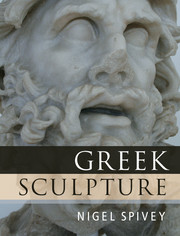Book contents
- Frontmatter
- Dedication
- Contents
- List Of Figures
- Preface
- Note
- 1 Introduction: the Study Of Greek Sculpture
- 2 The Greek Revolution
- 3 Daedalus and the Wings of Technê
- 4 Anathêmata: Gifts for the Gods
- 5 Heroes Apparent
- 6 Temple Stories
- 7 In Search of Pheidias
- 8 Revealing Aphrodite
- 9 Royal Patronage
- 10 Portraits and Personifications
- 11 Graecia Capta
- 12 Afterlife
- Index
1 - Introduction: the Study Of Greek Sculpture
Published online by Cambridge University Press: 01 December 2014
- Frontmatter
- Dedication
- Contents
- List Of Figures
- Preface
- Note
- 1 Introduction: the Study Of Greek Sculpture
- 2 The Greek Revolution
- 3 Daedalus and the Wings of Technê
- 4 Anathêmata: Gifts for the Gods
- 5 Heroes Apparent
- 6 Temple Stories
- 7 In Search of Pheidias
- 8 Revealing Aphrodite
- 9 Royal Patronage
- 10 Portraits and Personifications
- 11 Graecia Capta
- 12 Afterlife
- Index
Summary
The primary motive for studying the art of ancient Greece can be easily stated: its sheer beauty, which beyond our delight and wonder may demand some explanation. But that is an aesthetic sentiment, and such sentiments carry little weight nowadays. So we are obliged to summarize why the endeavour involved in ‘understanding Greek sculpture’ is objectively worth our time and intellectual effort.
As a logical progression, the reasoning might go as follows. Whether or not we agree that Greek sculpture is generally ‘beautiful’ to behold, there is no doubt that the artists who created this work, and those who commissioned it, were aware of the capacity of three-dimensional images to cause delight, wonder and awe. The potential for enchantment was there from the beginning; we have not invented it. The archaeological contexts of early Greek sculpture make it clear that it was originally and essentially produced as ‘gifts for the gods’: as such, intended for marvellous display.
That certain craft techniques were developed by Greek sculptors with the aim of making their work ‘marvellous’ is equally evident, whether from the material remains of the work itself or circumstantial inscriptions and ancient literature. In the history of Western art, there is no place and period to compare with what happened in the Greek world between c. 800 BC to c. 300 BC: a half-millennium of technical innovation and refinement, rooted in a continuity of artistic tradition that was often passed on from father to son. An apprentice in Greek sculpture might very well start work aged 7 or 8 (a letter survives from the Athenian Agora, written to his mother by one very unhappy boy set to work in a foundry). It is tempting to relate this custom to the modern reductive calculus whereby ‘genius’ relies upon some 10,000 hours of practice.
At Cambridge University (for example), the study of Greek sculpture has been part of the Classics curriculum since the early 1880s; today, it is widely diffused in school and university courses, particularly those titled around the concept of ‘Classical Civilization’. Why so?
- Type
- Chapter
- Information
- Greek Sculpture , pp. 1 - 15Publisher: Cambridge University PressPrint publication year: 2013



